Fractal Tilings with Prototiles that can be Generated by Dissecting Polyiamonds
As with polyominoes, many polyiamonds have straight-line segments longer than one triangle edge. However, there is a good variety of true edge-to-edge f-tilings. As a result, pseudo-edge-to-edge f-tilings will not be considered unless specifically noted.
A little analysis shows that candidate polyiamonds must have 2-fold, 3-fold, or 6-fold rotational symmetry. For 3-fold and 6-fold, prototiles with an odd number of edges will not admit f-tilings. It is also helpful to note that no polyiamonds made up of an odd number of equilateral triangles possess 2-fold rotational symmetry. Furthermore, any polyiamond possessing 6-fold rotational symmetry must be made up of 6n equilateral triangles, where n is an integer.
Most lower-order polyiamonds do not yield prototiles that admit f-tilings. All of those that do are listed below through 12-iamonds, to the best of my knowledge, though I haven't rigorously ruled out all other possibilities.
There are no prototiles, that admit f-tilings, generated from polyiamonds made up of 1, 3, 4, 5, 7, 9, 10, 11, or 13 equilateral triangles.
There is a single 2-iamond f-tiling:


There is a single 6-iamond f-tiling:


There is a single 8-iamond f-tiling:


There are at least six 12-iamond f-tilings:











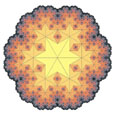
Some f-tilings generated from higher-order polyiamonds follow.
An 18-iamond-based prototile:

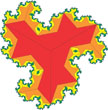
A 24-iamond-based prototile:


A 30-iamond-based prototile:

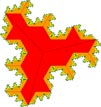
A 36-iamond-based prototile:

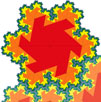
A 48-iamond-based prototile:


A 54-iamond-based prototile:

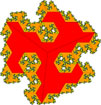
Go to Fractal Tiling Compendium Home
Webmaster: Robert Fathauer; rob@tessellations.com




























